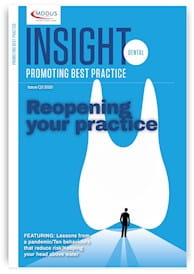 NO doubt you will have been told many times of the importance of clear clinical notes, detailing the treatment given to patients. There is nothing new in this advice. But what has changed in recent years is the requirement for increasingly more comprehensive notes.
NO doubt you will have been told many times of the importance of clear clinical notes, detailing the treatment given to patients. There is nothing new in this advice. But what has changed in recent years is the requirement for increasingly more comprehensive notes.
Some practitioners have not embraced this development and continue to write more minimal notes. This practice can leave dentists particularly vulnerable when facing a complaint to the practice, a complaint to the General Dental Council (GDC), a counter fraud investigation or a civil claim for damages.
Don’t assume that “it will never happen to me”. Very few dental practitioners will be immune from some form of complaint or claim – and this can happen to more experienced dentists just as easily as those embarking on their career. Any complaint is costly in terms of time, reputation and the anxiety it causes. Best avoided if at all possible!
A good defence
Whilst you may not be able to prevent a claim or complaint being intimated by a patient, you can minimise the repercussions by taking good notes. A claim or complaint can be intimated many years after the treatment in question was provided. Civil claims are time-barred three years from the date of the negligent act or from the date that the patient becomes aware that there has been negligence. You would be surprised how many patients delay in raising a claim until many years after the event. It is highly improbable that in a busy practice you would remember all the details of a root canal treatment that you undertook that long ago.
In court, a dispute in relation to treatment provided becomes an issue of credibility. Whose version will the court prefer? If the clinical notes do not record the justification for the treatment provided or the options discussed, litigation then becomes an even riskier proposition. Many claims have to be settled because the fundamental basics are just not present in the notes.
No excuses
Patient notes are your responsibility and yours alone. It is simply not good enough to say that you are working in a busy NHS practice and did not have sufficient time to write full notes, or that the other dentists in the practice write short notes and therefore your practice has had to adapt. Worse still is to blame your nurse. The court or the GDC will be unimpressed by such excuses. Your role is to provide a consistently good standard of record keeping.
The GDC’s Standards for the dental team sets out the principles and standards to be followed. At 4.1, the guidance states: “You must make and keep complete and accurate patient records, including an up-to-date medical history, each time that you treat patients.
“You should record as much detail as possible about the discussions you have with your patients, including evidence that valid consent has been obtained.
”You must ensure that all documentation that records your work, including patient records, is clear, legible, accurate and can be readily understood by others. You must also record the name or initials of the treating clinician."
In addition, the Faculty of General Dental Practice (FGDP (UK)) has its Clinical Examination and Record Keeping: Good Practice Guidelines from 2016. This comprehensive guide provides specific and detailed information on record keeping and examination, and recommendations for audit.
If you are in any doubt at all about the requirements in relation to contemporaneous notes, then you should contact MDDUS for assistance and guidance. Below are some important dos and don’ts.
Dos
- Teamwork in record keeping can be very effective. Establish a good relationship with your dental nurse if they record your notes whilst you dictate them. Always check the notes and add your own additional observations if required. The overall responsibility for the notes remains with you.
- Identify the note as yours either by initials or by your signature if it is handwritten.
- Record all treatment provided, the taking of consent, treatment discussions, advice given about oral hygiene, advice about treatment options, aftercare and both positive and salient negative findings (remember that negative results may be as important as positive ones).
- Use only universally agreed dental abbreviations.
- Be sure to identify other contacts cited in notes (consultant, nurse, relative, etc).
- When drawing up a treatment plan, ensure that it is revised (as necessary), document any changes and review regularly. When taking an X-ray, note the reason why, grading, the result reported upon and any differential diagnosis.
- The medical history should be reviewed regularly and updated. This forms part of the dental record and should be readily accessible.
- Audit your records regularly to prove that your note taking remains up to a certain standard. Take advice on how to audit effectively. Guidance is available on the NES website and in the FGDP (UK) guidelines referred to above.
- Ensure your notes can justify the claims made. Diagnosis and justification for treatment need to be clearly evident in the records, along with detail of the treatment provided.
- When using local anaesthetic, ensure that the dose and expiry date are recorded. In particular ensure that the use of local anaesthetic is recorded when fillings are provided.
- Where records are not written contemporaneously, ensure this is clearly documented.
- Ensure notes use neutral language and are in no way derogatory – don’t forget they could be seen by others including the patient.
Don’ts
- When making handwritten notes, do not write in pencil as this raises suspicion of improper practice or claims. Always use ink or a ball point pen in a colour which can be scanned or photocopied.
- Do not obliterate any record. If altering a record, put a single line through the entry to be corrected then date and initial it.
- Do not write notes at a later date: this includes additions to the contemporaneous notes. If records are amended, the reason should be clear and transparent, and the audit trail should maintain a record of the changes. Where handwritten records are used make the date of the amendment clear.
- Do not rely on autotext or pre-populated templates. Any such autotext needs to be reviewed and completed so that the detail of the records accurately reflects that particular patient contact.
From the perspective of MDDUS, the availability of good, accurate records will substantially assist our ability to put forward a good defence either to a civil claim or GDC complaint. But more importantly, good notes are fundamental to good patient care. Notes allow essential communication with other dentists who may be required to continue your treatment. Poor records are often interpreted as indicative of poor and sloppy management.
Taking the time now to read the available standards and guidelines to ensure a good standard of note taking could save heartache in the future.
Case study
A dental patient lodges a claim after having suffered nerve damage during an implant procedure, leading to lip numbness. She states that she would have chosen an alternative treatment had she known of this risk. The dentist claims that he informed the patient of the risk and other available treatment options, but no record was made of these discussions in the patient notes.
Analysis
The dentist in this case would have difficulty in proving what was discussed without this having been recorded in the notes. The fact that the dentist did not record this discussion means the case could be difficult to defend in court, as the outcome may boil down to a question of whether the judge prefers the evidence of the dentist (as to his recollections and usual practice), or that of the patient.
Useful links
- GDC – Standards for the dental team
- FGDP (UK) – Clinical examination and record keeping: Good practice guidelines 2016
- MDDUS Dental risk toolbox – Clinical dental record keeping
Lindsey McGregor is a solicitor at MDDUS
This article was updated on November 30, 2020
This page was correct at the time of publication. Any guidance is intended as general guidance for members only. If you are a member and need specific advice relating to your own circumstances, please contact one of our advisers.
Read more from this issue of Insight Dental

Save this article
Save this article to a list of favourite articles which members can access in their account.
Save to library
